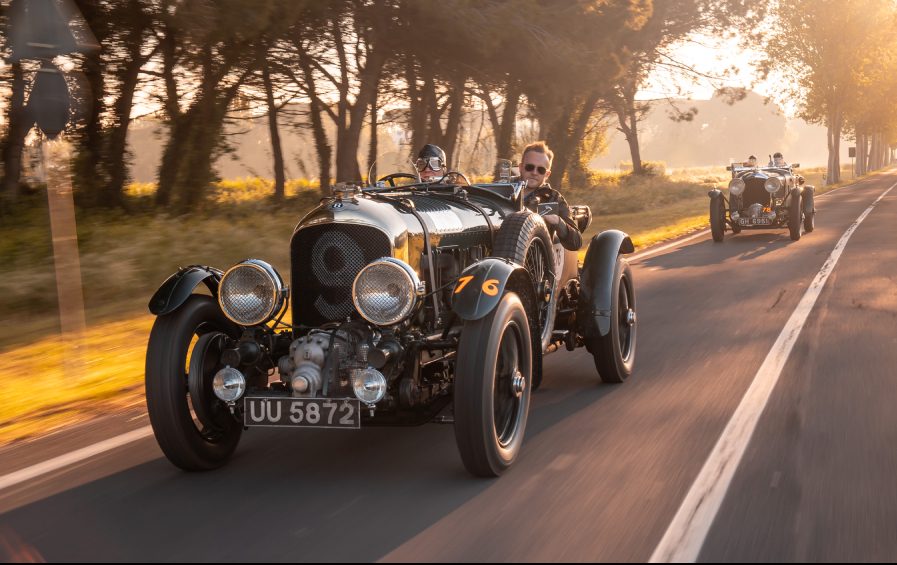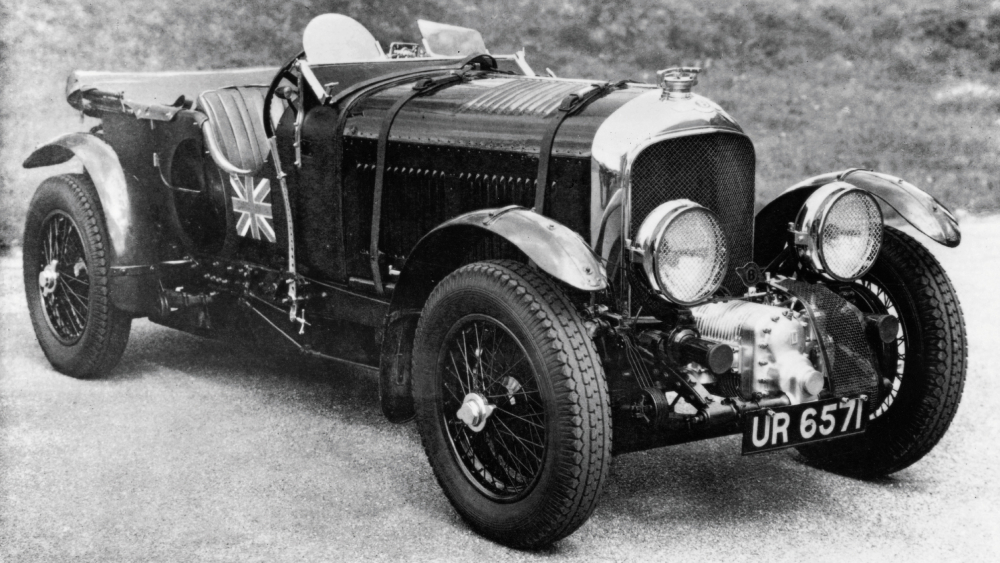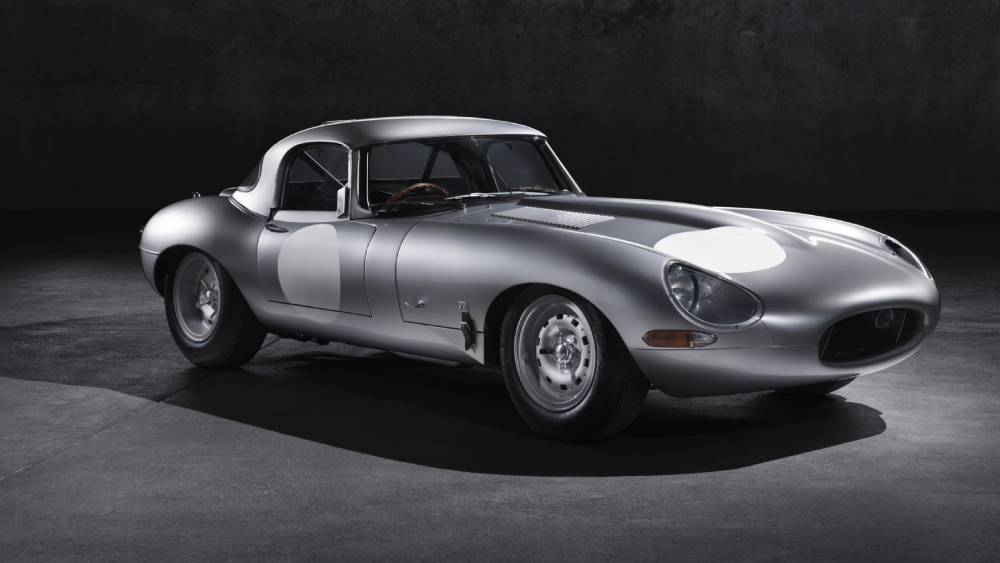
Robb Read: The Rise Of Continuation Cars
Are these reproductions the stuff of collectors’ dreams or just an elaborate marketing ruse?
Related articles
The letter, dated March 20, 2020, was addressed to Adrian Hallmark, chairman and CEO of British automaker Bentley. It began with a nostalgic recap of the marque’s storied triumphs in races a century ago, before getting, politely, to the point.
“Understandably, over many years, Bentley Motors’ marketing department has sought to maximise this remarkable heritage,” the letter reads. “Bentley Motors Ltd. has often had recourse to supportive private owners—such as ourselves—to provide one or more of our genuine period cars for various company promotions and events which we have willingly encouraged. Against such a supportive background, we are now writing to express our shared concern and dismay upon hearing of your company’s apparent plans to build and market a batch of 12 replica ‘Blower’ Bentleys for premium-price sale.”
What gave the correspondence unusual gravitas was that the 10 signatories are among the most prominent car collectors in the world, including fashion designer Ralph Lauren, JCB construction-equipment billionaire Lord Bamford, California real-estate developer John Mozart, Walmart heir Rob Walton and international classic-car consultant Simon Kidston. They described their group as “lifelong enthusiasts for the Bentley marque” and concluded, with commendable snark, “Marketing people—in their understandable enthusiasm—often fail to grasp matters not only of detail, but also of basic truth. We urge you to please not squander time, funding, energy and the Bentley brand’s reputation upon the recently announced batch of 12 facsimile cars, cars that would serve only to dilute that special admiration and awe that can only come from viewing and embracing the genuine article. To do otherwise would be
to pervert a glorious history.”
To understand what’s at stake here, let’s take a step back. Gearheads have been dabbling with kit cars and aftermarket replicas since the 1950s, when cheaper fibreglass bodies and inexpensive chassis flooded the market. But this new breed is on a different level entirely. Unlike those knock-offs, continuation cars are made, or officially licensed, by the original manufacturer and painstakingly constructed to the same period specifications as the initial models, save for certain contemporary safety and handling features. Notably, their chassis and engine numbers often follow their predecessors sequentially, effectively continuing a bygone model’s production.
The genesis for Bentley’s endeavour is the second of four machines built and raced by Sir Henry “Tim” Birkin at Le Mans early last century. Birkin’s “No. 2” Blower is owned by Bentley, though similar examples—50 production cars were made—can fetch anywhere from approx. $6.5 million to approx. $26 million.
Birkin was one of the celebrated Bentley Boys, gentlemen racers who piloted the marque to first-place finishes at the 24 Hours of Le Mans from 1927 through 1930. The winning drive team that final year was Woolf Barnato and Glen Kidston, Simon’s late uncle, which helps explain the nephew’s misgivings about tinkering with legacy.
“Brands that are doing well shouldn’t need to resort to raiding their back catalogues, and I don’t believe it reflects well on them,” says Kidston, steward to his family’s own impressive motoring assemblage and consultant for others in the arena. “It detracts from the rarity of the originals and effectively undermines the real heritage of the brand. We’re not singling out Bentley. I think the same is true of others who have jumped on the ‘authentic replica’ bandwagon.”
There are longer-term ramifications, too, he says. “It creates the potential for confusion in the future over what is real and what is not. Anything built purely to be a collector’s item rarely becomes one, long-term. There is no integrity of purpose to a new copy whose sole aim for the manufacturer is to make money. It has no intrinsic value. Only age, history and authenticity confer that magic.” Kidston compares continuation cars to “trying to replicate a vintage wine just by analysing its components and passing the resulting mix off as ‘new old vintage.’ ”
Others share his concern. Bruce Meyer, a director of the Petersen Automotive Museum and the owner of a large stable of noteworthy vehicles, recognises that continuations allow those who can’t afford the original to get in the game, but “if you’re a serious collector, you want to stay away from continuations. They will contaminate the authenticity of your entire collection.”
What fuels the worth of any collectible is scarcity, so clearly when a diminishing supply begins to replenish, alarm grows as perceived value dips. Take the Porsche 993, the fourth generation of the 911 model. As the last iteration to feature the marque’s air-cooled flat-six engine, it has become highly coveted by Porschephiles and aftermarket tuners, who have driven prices as high as seven figures in some cases. Hypothetically, if Porsche brought the air-cooled engine back into production, the 993 would become an asterisk instead of an exclamation point on a connoisseur’s wish list—the rarity bubble would burst.
Those in the pro camp see things a little differently. For the leader of Bentley’s project, Tim Hannig, the decision to revisit the Blower was a pragmatic response to increase a specific vehicle’s longevity. “The original car is used a lot”—for promotions, events, VIP rides and the like—“probably more than it should be according to its age and value,” he tells
Robb Report. “The idea was born to create a toolroom copy to do a lot of the work.” Once the word got out, there were requests from the Bentley faithful for a few more.
The process of building a period-correct facsimile from scratch involves what Hannig refers to as “industrial archaeology”: his team scoured the archives for outlines and documentation of materials, stripped major portions of the car, then completely scanned it to generate a digital model. One of the greatest challenges, he says, was the 4.9-metre sheet-metal chassis, which relied on old-fashioned hammer work and a machine dating to 1899.
“We’re using modern technologies to get to our target but traditional methods to create the actual assets that go on the car,” he says. “If we waited a bit longer, the craftsmanship skills would definitely be gone. It’s a fantastic way of not just storing the ashes of a period but really keeping the fire glowing, even on a small scale.”
A pioneer of the trend was Jaguar, which opened its restoration and heritage centre, Jaguar Classic, in 2014. Re-creating a benchmark car was the first order of operation, since it would best showcase the division’s capabilities. But the idea to resurrect the past was also based on a sense of unfinished business.
“For a number of different reasons, the planned production runs of some of our most iconic vehicles weren’t always completed in period,” says Dan Pink, director of Jaguar Classic. “Our continuation programs have allowed us to correct this. It’s also a valuable learning exercise for our team, cascading the knowledge and expertise from previous generations to get under the skin of our prized machines.”
The focus thus far has been on three models from the marque’s golden age in the 1950s and ’60s: the D-type, the XKSS and the E-type. In 1963, Jaguar planned to build 18 copies of a Special GT E-type, but only 12 were completed—that is, until 2016, when the final six examples were finished to such faithful reproduction that they qualified for historic-racing certification through the Fédération Internationale de l’Automobile.
Jaguar then returned to the XKSS, a street version of its D-type racer. Only 16 of the initial 25 cars survived a factory fire in 1957; the last of the nine replacements was completed 61 years
later, in 2018. Jaguar also announced production of 25 “new” D-types, some of which are still in the works, though already pre-sold. (The XKSS and E-type continuations have all been delivered.)
One reason for the demand is that original concours-quality examples of the D-type command in the neighbourhood of approx. $11.5 million (although one fetched approx. $27 million at auction in 2016), while the contemporaries sell for roughly one-ninth that price. As Meyer noted earlier, continuation cars can be a gateway drug for those who don’t yet have the resources to invest in the real thing. Or for those who have nearly unlimited funds, they’re a way to protect a more valuable investment in an original: a niche position to be sure, but one that holds outsize sway in the most rarefied stratum of the car-collecting world.
“They provide collectors the freedom to enjoy their cars without the anxiety and cost of running the originals,” says Peter Mullin, another Petersen board member and founder of the Mullin Automotive Museum, also in Southern California. “The last thing we would want is to wreck a 70-year-old fender or scratch an original paint job. For daily or even weekend drives, continuation cars are the best option.”
Mullin’s perspective is backed by Paul Spires, president of Aston Martin Works, the marque’s restoration and preservation department. Spires readily admits that there were those in the Aston community worried about classics being revisited, but “when they came here and saw the quality, passion and dedication of the team involved, their fears were very quickly allayed,” he says. “Some owners of original cars went on to purchase one or more continuations themselves.”
After re-creating 25 examples of Aston’s famed 1959–63 DB4 GT in 2017 (priced at approx. $2.5 million apiece), Spires and co. have revisited the DB4 GT Zagato of the early 1960s, with a run of 19 new additions, and are currently focused on reviving one of the most famous cars in the world—the DB5 that the late Sir Sean Connery drove in the 1964 James Bond film, Goldfinger. The 25 DB5 Goldfinger Continuation cars will be equipped with the same embellishments used by 007, including a smoke-screen system, revolving license plates and bullet-resistant glass. But while the new release costs approx. $4.7 million, one of the actual coupes used to promote the film franchise in the mid-1960s sold for approx. $8.3 million at auction in August 2019, during Monterey Car Week in California. You can, it seems, put a price on provenance.
But for many brands and collectors alike, the philosophy behind continuation cars is about more than money. Mullin believes continuations “reignite a passion among younger enthusiasts and further the hobby,” and he’s right, at least according to Stateside constructor Lance Stander and his team at Superformance. It’s the only outside entity licensed to recreate benchmark 289 and 427 variants of the classic Shelby Cobra—developed by the late Carroll Shelby, who\subsequently endorsed their work—as well as the GT40s that Shelby helped develop for Ford. “We have buyers in their late 20s and early 30s,” Stander says. “One designs computer games and has bought two GT40s and a Cobra from us.”
If collectors can’t decide whether these cars are an abomination or highly desirable, then perhaps the market will.
“Nobody knew what was going to happen as the global economy changed back in March, but right now the market [for collectibles] is very strong,” says Brian Rabold, vice president of valuation services at Hagerty Classic Insurance, experts in high-end automotive coverage. According to Hagerty’s estimates, many of the aforementioned originals increased in price or remained static after the newbies’ appearance on the scene, notwithstanding the uncertainty of the past 12 months (see “Time Will Tell” opposite page).
So the value of the originals has remained strong. But so too has that of the newcomers. Auction house RM Sotheby’s had an example from each of the three Jaguar continuations cross the block in October 2020. The least expensive sold for approx. $1.71 million and the most for approx. $2.6 million—evidence, surely, of an audience willing to make room for these cars in the canon. “These [continuation] cars are part of their own distinct category—not replicas, but not a classic original,” says Alexander Weaver, car specialist at RM Sotheby’s. “Interestingly, some are even rarer than the initial model”—such as Jaguar’s D-type continuation, which saw just a third of the original’s 75-unit production—“making them that much more desirable.”
Could it be that continuation cars are just that: a way of maintaining a legacy that, without new impetus, would wither and die? Do we want a future where a priceless old Blower turns to rust under a cover because there are no longer technicians capable of maintaining it, even if that deterioration drives the car’s valuation up instead of down? Perhaps the basic truth is simpler. While this may not be the case forever—and while they may not care to admit it—could it be that right now everyone with interests in the continuation game gets to win . . . whatever they write in their letters?
Subscribe to the Newsletter
Recommended for you
8 Fascinating Facts You Didn’t Know About Aston Martin
The British sports car company is most famous as the vehicle of choice for James Bond, but Aston Martin has an interesting history beyond 007.
May 1, 2024
Rezvani Will Rebuild Your 911 to Go From Zero to 100 in Two Seconds
The shop will build a version of the RR1 based on the Carrera S, GT3, and Turbo S
By Bryan Hood
April 23, 2024
You may also like.
You may also like.
Watch of the Week: TAG Heuer Formula 1 | Kith
The legendary sports watch returns, but with an unexpected twist.
Over the last few years, watch pundits have predicted the return of the eccentric TAG Heuer Formula 1, in some shape or form. It was all but confirmed when TAG Heuer’s heritage director, Nicholas Biebuyck, teased a slew of vintage models on his Instagram account in the aftermath of last year’s Watches & Wonders 2023 in Geneva. And when speaking with Frédéric Arnault at last year’s trade fair, the former CEO asked me directly if the brand were to relaunch its legacy Formula 1 collection, loved by collectors globally, how should they go about it?
My answer to the baited entreaty definitely didn’t mention a collaboration with Ronnie Fieg of Kith, one of the world’s biggest streetwear fashion labels. Still, here we are: the TAG Heuer Formula 1 is officially back and as colourful as ever.
As the watch industry enters its hype era—in recent years, we’ve seen MoonSwatches, Scuba Fifty Fathoms, and John Mayer G-Shocks—the new Formula 1 x Kith collaboration might be the coolest yet.

Here’s the lowdown: overnight, TAG Heuer, together with Kith, took to socials to unveil a special, limited-edition collection of Formula 1 timepieces, inspired by the original collection from the 1980s. There are 10 new watches, all limited, with some designed on a stainless steel bracelet and some on an upgraded rubber strap; both options nod to the originals.
Seven are exclusive to Kith and its global stores (New York, Los Angeles, Miami, Hawaii, Tokyo, Toronto, and Paris, to be specific), and are made in an abundance of colours. Two are exclusive to TAG Heuer; and one is “shared” between TAG Heuer and Kith—this is a highlight of the collection, in our opinion. A faithful play on the original composite quartz watch from 1986, this model, limited to just 1,350 pieces globally, features the classic black bezel with red accents, a stainless steel bracelet, and that creamy eggshell dial, in all of its vintage-inspired glory. There’s no doubt that this particular model will present as pure nostalgia for those old enough to remember when the original TAG Heuer Formula 1 made its debut.

Of course, throughout the collection, Fieg’s design cues are punctuated: the “TAG” is replaced with “Kith,” forming a contentious new brand name for this specific release, as well as Kith’s slogan, “Just Us.”
Collectors and purists alike will appreciate the dedication to the original Formula 1 collection: features like the 35mm Arnite cases—sourced from the original 80s-era supplier—the form hour hand, a triangle with a dot inside at 12 o’clock, indices that alternate every quarter between shields and dots, and a contrasting minuterie, are all welcomed design specs that make this collaboration so great.
Every TAG Heuer Formula 1 | Kith timepiece will be presented in an eye-catching box that complements the fun and colour theme of Formula 1 but drives home the premium status of this collaboration. On that note, at $2,200 a piece, this isn’t exactly an approachable quartz watch but reflects the exclusive nature of Fieg’s Kith brand and the pieces he designs (largely limited-edition).

So, what do we think? It’s important not to understate the significance of the arrival of the TAG Heuer Formula 1 in 1986, in what would prove integral in setting up the brand for success throughout the 90’s—it was the very first watch collection to have “TAG Heuer” branding, after all—but also in helping to establish a new generation of watch consumer. Like Fieg, many millennial enthusiasts will recall their sentimental ties with the Formula 1, often their first timepiece in their horological journey.
This is as faithful of a reissue as we’ll get from TAG Heuer right now, and budding watch fans should be pleased with the result. To TAG Heuer’s credit, a great deal of research has gone into perfecting and replicating this iconic collection’s proportions, materials, and aesthetic for the modern-day consumer. Sure, it would have been nice to see a full lume dial, a distinguishing feature on some of the original pieces—why this wasn’t done is lost on me—and perhaps a more approachable price point, but there’s no doubt these will become an instant hit in the days to come.
—
The TAG Heuer Formula 1 | Kith collection will be available on Friday, May 3rd, exclusively in-store at select TAG Heuer and Kith locations in Miami, and available starting Monday, May 6th, at select TAG Heuer boutiques, all Kith shops, and online at Kith.com. To see the full collection, visit tagheuer.com
You may also like.
8 Fascinating Facts You Didn’t Know About Aston Martin
The British sports car company is most famous as the vehicle of choice for James Bond, but Aston Martin has an interesting history beyond 007.
Aston Martin will forever be associated with James Bond, ever since everyone’s favourite spy took delivery of his signature silver DB5 in the 1964 film Goldfinger. But there’s a lot more to the history of this famed British sports car brand beyond its association with the fictional British Secret Service agent.
Let’s dive into the long and colourful history of Aston Martin.
You may also like.
What Venice’s New Tourist Tax Means for Your Next Trip
The Italian city will now charge visitors an entry fee during peak season.
Visiting the Floating City just got a bit more expensive.
Venice is officially the first metropolis in the world to start implementing a day-trip fee in an effort to help the Italian hot spot combat overtourism during peak season, The Associated Press reported. The new program, which went into effect, requires travellers to cough up roughly €5 (about $AUD8.50) per person before they can explore the city’s canals and historic sites. Back in January, Venice also announced that starting in June, it would cap the size of tourist groups to 25 people and prohibit loudspeakers in the city centre and the islands of Murano, Burano, and Torcello.
“We need to find a new balance between the tourists and residents,’ Simone Venturini, the city’s top tourism official, told AP News. “We need to safeguard the spaces of the residents, of course, and we need to discourage the arrival of day-trippers on some particular days.”
During this trial phase, the fee only applies to the 29 days deemed the busiest—between April 25 and July 14—and tickets will remain valid from 8:30 am to 4 pm. Visitors under 14 years of age will be allowed in free of charge in addition to guests with hotel reservations. However, the latter must apply online beforehand to request an exemption. Day-trippers can also pre-pay for tickets online via the city’s official tourism site or snap them up in person at the Santa Lucia train station.
“With courage and great humility, we are introducing this system because we want to give a future to Venice and leave this heritage of humanity to future generations,” Venice Mayor Luigi Brugnaro said in a statement on X (formerly known as Twitter) regarding the city’s much-talked-about entry fee.
Despite the mayor’s backing, it’s apparent that residents weren’t totally pleased with the program. The regulation led to protests and riots outside of the train station, The Independent reported. “We are against this measure because it will do nothing to stop overtourism,” resident Cristina Romieri told the outlet. “Moreover, it is such a complex regulation with so many exceptions that it will also be difficult to enforce it.”
While Venice is the first city to carry out the new day-tripper fee, several other European locales have introduced or raised tourist taxes to fend off large crowds and boost the local economy. Most recently, Barcelona increased its city-wide tourist tax. Similarly, you’ll have to pay an extra “climate crisis resilience” tax if you plan on visiting Greece that will fund the country’s disaster recovery projects.
You may also like.
Omega Reveals a New Speedmaster Ahead of the Paris 2024 Olympics
Your first look at the new Speedmaster Chronoscope, designed in the colour theme of the Paris Olympics.
The starters are on the blocks, and with less than 100 days to go until the Paris 2024 Olympics, luxury Swiss watchmaker Omega was bound to release something spectacular to mark its bragging rights as the official timekeeper for the Summer Games. Enter the new 43mm Speedmaster Chronoscope, available in new colourways—gold, black, and white—in line with the colour theme of the Olympic Games in Paris this July.
So, what do we get in this nicely-wrapped, Olympics-inspired package? Technically, there are four new podium-worthy iterations of the iconic Speedmaster.

The new versions present handsomely in stainless steel or 18K Moonshine Gold—the brand’s proprietary yellow gold known for its enduring shine. The steel version has an anodised aluminium bezel and a stainless steel bracelet or vintage-inspired perforated leather strap. The Moonshine Gold iteration boasts a ceramic bezel; it will most likely appease Speedy collectors, particularly those with an affinity for Omega’s long-standing role as stewards of the Olympic Games.
Notably, each watch bears an attractive white opaline dial; the background to three dark grey timing scales in a 1940s “snail” design. Of course, this Speedmaster Chronoscope is special in its own right. For the most part, the overall look of the Speedmaster has remained true to its 1957 origins. This Speedmaster, however, adopts Omega’s Chronoscope design from 2021, including the storied tachymeter scale, along with a telemeter, and pulsometer scale—essentially, three different measurements on the wrist.
While the technical nature of this timepiece won’t interest some, others will revel in its theatrics. Turn over each timepiece, and instead of a transparent crystal caseback, there is a stamped medallion featuring a mirror-polished Paris 2024 logo, along with “Paris 2024” and the Olympic Rings—a subtle nod to this year’s games.
Powering this Olympiad offering—and ensuring the greatest level of accuracy—is the Co-Axial Master Chronometer Calibre 9908 and 9909, certified by METAS.

A Speedmaster to commemorate the Olympic Games was as sure a bet as Mondo Deplantis winning gold in the men’s pole vault—especially after Omega revealed its Olympic-edition Seamaster Diver 300m “Paris 2024” last year—but they delivered a great addition to the legacy collection, without gimmickry.
However, the all-gold Speedmaster is 85K at the top end of the scale, which is a lot of money for a watch of this stature. By comparison, the immaculate Speedmaster Moonshine gold with a sun-brushed green PVD “step” dial is 15K cheaper, albeit without the Chronoscope complications.
—
The Omega Speedmaster Chronoscope in stainless steel with a leather strap is priced at $15,725; stainless steel with steel bracelet at $16,275; 18k Moonshine Gold on leather strap $54,325; and 18k Moonshine Gold with matching gold bracelet $85,350, available at Omega boutiques now.
Discover the collection here
You may also like.
Here’s What Goes Into Making Jay-Z’s $1,800 Champagne
We put Armand de Brignac Blanc de Noirs Assemblage No. 4 under the microsope.
In our quest to locate the most exclusive and exciting wines for our readers, we usually ask the question, “How many bottles of this were made?” Often, we get a general response based on an annual average, although many Champagne houses simply respond, “We do not wish to communicate our quantities.” As far as we’re concerned, that’s pretty much like pleading the Fifth on the witness stand; yes, you’re not incriminating yourself, but anyone paying attention knows you’re probably guilty of something. In the case of some Champagne houses, that something is making a whole lot of bottles—millions of them—while creating an illusion of rarity.
We received the exact opposite reply regarding Armand de Brignac Blanc de Noirs Assemblage No. 4. Yasmin Allen, the company’s president and CEO, told us only 7,328 bottles would be released of this Pinot Noir offering. It’s good to know that with a sticker price of around $1,800, it’s highly limited, but it still makes one wonder what’s so exceptional about it.
Known by its nickname, Ace of Spades, for its distinctive and decorative metallic packaging, Armand de Brignac is owned by Louis Vuitton Moët Hennessy and Jay-Z and is produced by Champagne Cattier. Each bottle of Assemblage No. 4 is numbered; a small plate on the back reads “Assemblage Four, [X,XXX]/7,328, Disgorged: 20 April, 2023.” Prior to disgorgement, it spent seven years in the bottle on lees after primary fermentation mostly in stainless steel with a small amount in concrete. That’s the longest of the house’s Champagnes spent on the lees, but Allen says the winemaking team tasted along the way and would have disgorged earlier than planned if they’d felt the time was right.
Chef de cave, Alexandre Cattier, says the wine is sourced from some of the best Premier and Grand Cru Pinot Noir–producing villages in the Champagne region, including Chigny-les-Roses, Verzenay, Rilly-la-Montagne, Verzy, Ludes, Mailly-Champagne, and Ville-sur-Arce in the Aube département. This is considered a multi-vintage expression, using wine from a consecutive trio of vintages—2013, 2014, and 2015—to create an “intense and rich” blend. Seventy percent of the offering is from 2015 (hailed as one of the finest vintages in recent memory), with 15 percent each from the other two years.

This precisely crafted Champagne uses only the tête de cuvée juice, a highly selective extraction process. As Allen points out, “the winemakers solely take the first and freshest portion of the gentle cuvée grape press,” which assures that the finished wine will be the highest quality. Armand de Brignac used grapes from various sites and three different vintages so the final product would reflect the house signature style. This is the fourth release in a series that began with Assemblage No. 1. “Testing different levels of intensity of aromas with the balance of red and dark fruits has been a guiding principle between the Blanc de Noirs that followed,” Allen explains.
The CEO recommends allowing the Assemblage No. 4 to linger in your glass for a while, telling us, “Your palette will go on a journey, evolving from one incredible aroma to the next as the wine warms in your glass where it will open up to an extraordinary length.” We found it to have a gorgeous bouquet of raspberry and Mission fig with hints of river rock; as it opened, notes of toasted almond and just-baked brioche became noticeable. With striking acidity and a vein of minerality, it has luscious nectarine, passion fruit, candied orange peel, and red plum flavors with touches of beeswax and a whiff of baking spices on the enduring finish. We enjoyed our bottle with a roast chicken rubbed with butter and herbes de Provence and savored the final, extremely rare sip with a bit of Stilton. Unfortunately, the pairing possibilities are not infinite with this release; there are only 7,327 more ways to enjoy yours.































